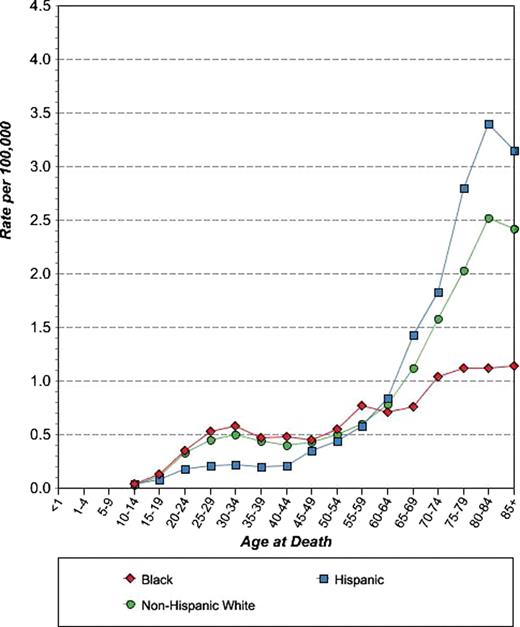Abstract
Abstract 2683
Pediatric HL studies have suggested survival differences based on ethnicity. However, little data is available regarding the impact, if any, of ethnicity on incidence patterns, disease histology, and/or survival among adult HL.
We examined data for 13 US SEER areas, several of which contain large Hispanic and Black populations. Case information was obtained from the 11/2009 SEER data submission released April 2010. We analyzed incidence, HL histology, and mortality rates according to ethnicity, age, and gender. We also examined incidence patterns across the past four decades. All analyses used SEER*Stat.
A total of 16,783 HL cases were diagnosed among residents in the 13 SEER registry areas during 1992–2007, with non-Hispanic Whites contributing the largest number (n=11,890), followed by Hispanics (n=2,190), and Blacks (n=1,724). Consistent with SEER 9 results (1973 data), Whites show a continued bimodal age-incidence curve (6.0/100,000 ages 25–29, 2.5/100,000 ages 50–54, and 4.5/100,000 age 75–79). However, Blacks have a much less apparent bimodal pattern (4.5/100,000 ages 25–29, 2.6/100,000 ages 50–54, and 3.0/100,000 ages 75–79), while Hispanics are distinctly not bimodal with a small increase at 20–24 (2.4/100,000) followed by an exponential-like increase with peak HL incidence at ages 80–84 (7.0/100,000). Moreover, among persons >65 years, HL is currently significantly more common in Hispanics than Whites (4.7-7.0/100,000 vs 3.9–4.5/100,000, respectively, p<0.05). With gender, HL is more common in males than females, regardless of ethnicity. Interestingly, the male excess, however, does not occur until ages 30–34 (all ethnicities). Furthermore, from 1975–2007, HL incidence increased in Black females (annual percent change (APC) = 2.5; p<0.05) and White females (APC = 0.4; p<0.05). According to histology, both nodular sclerosis and mixed cellularity are more common in Whites followed by Blacks and Hispanics, while in persons age 60–84, both histologies are significantly more common in Hispanics compared with Whites and Blacks. Over the past 20 years, mortality has declined within each race by 10.3%–13.7% (p<0.05). However, age-specific ethnic survival disparities are apparent (Figure 1). For ages 65–84, Hispanics have a significantly increased mortality rate compared with Whites/Blacks (p<0.05). Conversely, among ages 20–44, Hispanics have a lower mortality rate versus Whites and Blacks.
Multiple important epidemiologic and mortality differences are evident across and within ethnicities in adult HL.
Hodgkin Lymphoma Age-Specific (Crude) U.S. Mortality Rates By Ethnicity.*
*Both sexes (1992-2007). Rates are per 100,000. Mortality source: US Mortality Files, National Center for Health Statistics, CDC. Accessed August 12th, 2010.
No relevant conflicts of interest to declare.
Author notes
Asterisk with author names denotes non-ASH members.


This feature is available to Subscribers Only
Sign In or Create an Account Close Modal